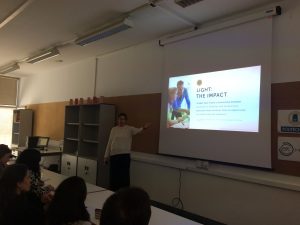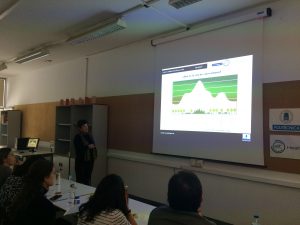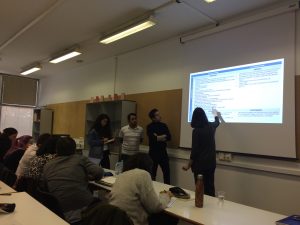Hello to everybody!!
This week we have the opportunity to have a look to the implementation of healthy aspects when we talk about design and operational features of projects and also a practical approach to measuring and monitoring data in a real case study.
We started the day with the presentation of Susana Saiz, associate director of ARUP in Madrid. She introduced the WELL Building Standard methodology. Considering we spend more of a 90% of our lifetime in indoor spaces, we have to be aware that there are several features that influence health and well-being. These features are taken into consideration by the WELL Building Standard and it compilates several issues that shall be accomplished for the indoor quality.
Air quality, noise levels, temperature comfort, lighting regulation to accompany circandian rhythms, availability of good quality food, spaces for fitness and for distress and relax are some of the features that have been explored during this presentation illustrated with examples.

Susana Saiz introducing the features of WELL Building Standard methodology.
Also, a brief introduction to Social Return on Investment methodology was also presented. An interesting methodology useful to value the importance of the intangible features while the implementation or development of a project.
In the afternoon, professor Emilia Román, from Universidad Politécnica de Madrid, presented the project MODIFICA, a research study in which she participated with ABIO Research group. The main objective of this research was to measure and analyse the evolution of the Urban Heat Island Effect in Madrid. Based in the previous research “El clima urbano de Madrid: la isla de calor” (López Gómez et al., 1988), they measured the difference of temperatures along three principal axes across Madrid.
This research has revealed the increase of temperatures inside the city during the last decades due to the reduction of natural surfaces. Madrid is a community that suffers a lack of natural areas and the consequences of this massive urbanisation growth have led to an important impact in climate conditions.

Professor Emilia Román showed us the research taken place in Madrid for analysing Urban Heat Island Effect.
Through several data measuring and then an interpolation process, they have obtained a cartography that shows the differences of temperatures and the heat island effect for the different areas of the city. It is remarquable the evidence of green spaces and natural areas in city center to contribute to the mitigation of this effect.
The problems associated to this urban heat island are multiples but, in the case of Usera neighborhood, the research revealed that this area had a greater impact. The structure of the demography (mainly elderly) and the poor housing conditions, make this neighborhood more vulnerable to this effect.
At the end of the session we shared the advances of some of the workshop groups and their SWOT analysis on their topics. We will continue next session with this review!

Group 3 first approach to the SWOT analysis of the neighborhood based on green areas and green and blue infrastructure.

Group 2 showed the main weaknesses of accesibility and spaces for walking for the elderly.

Group 1 presented us the main problems linked to thermal and noise comfort, security and identity in this neighborhood.
Also, next week we we will be introduced to the concept of environmental psychology and then visit again the neighborhood accompanied by an expert on accessibility and elderly needs!
Meet you next Monday!
UNI-Health Team
